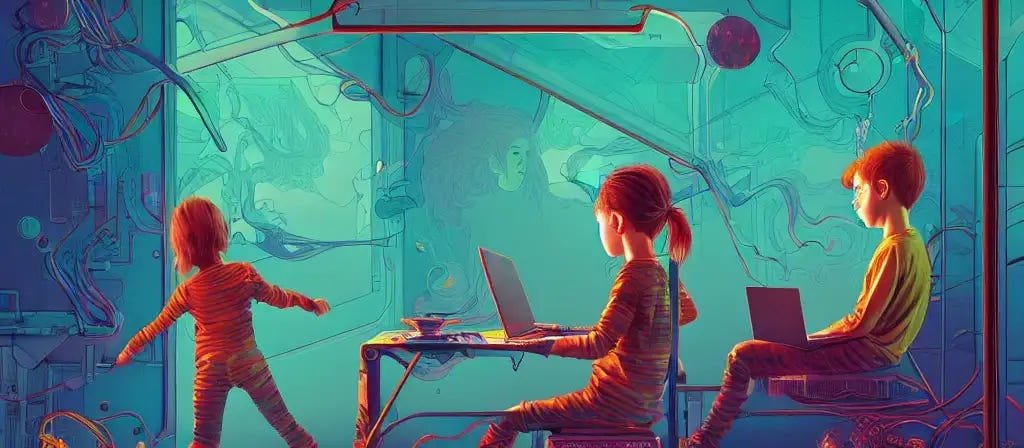The Four Shifts: Implications
Photography by Uwe Langmann
This is the second of a series on The Four Shifts that are revolutionizing every aspect of society and business.
1. Technology Shifts: AI, 5G, Biotech and Blockchain.
2. Power Shifts: From Center to Edge. From Institution to Individual. Consolidated to Fragmented.
3. Boundary Shifts: Office/Home boundaries. Blurring of behaviors. Mongrelized and Multi-Dimensional Companies.
4. Mind Shifts: Generational Differences. Re-evaluation of Work and other institutions.
The first of the Series which describes each of these shifts can be read here.
This second post discusses just some of the implications on Government, Education and Business.
Photography by Uwe Langmann
Government: New Models of Governance Emerge.
Most institutions at the national and international level were designed over five decades ago post World-War 2.
Today, two countries, India, and China, with nearly 3 billion people account for over 1 in 3 citizens of the world. And by the end of the decade Africa will contain 40 percent of the World’s people.
If you fly globally, you will find yourself landing and taking off in the middle of the night in many Asian and African countries because landings and take-offs have been optimized for United States and European travelers since these arrangements were written when air travel was primarily western which is no longer true.
The Internet reshapes borders in its own way and creates amazing opportunities and wealth as well as significant legal challenges when companies and the Internet are global, and laws are local. A company like Google has nearly 1000 in house lawyers and multiple outside legal firms since it and other companies like Meta have become a form of government and impact business and society everywhere. Current discussion on how to ensure Chinese ownership of TikTok is not leveraged against the West is an indicator of how the Internet is re-writing the rules.
It is not just the rise of the East and the Internet that is roiling governance but also modern healthcare and gene therapy. As modern medicine can extend the quantity of life but not the quality of life many want new rules on deciding when to exit. With every major country aging fast, this is just one of the issues we will grapple with.
The future will not fit in the organizations and governance of the past where we need to grapple with AI Ethics, Climate Change, Gene Technology, Data Privacy, an African-Asian future, and Space Junk/Wars and much more. We needed new rules for an Industrial Age since the rules of an Agricultural Age were no longer relevant. Similarly, the legal and institutional frameworks of the past cannot get us into the future.
In time this might give rise to what Balaji Srinivasan has named The Network State. The book asks that while Technology has enabled us to start new companies, new communities, and new currencies can we use it to start new cities, or even new countries? This book introduces the concept of the network state: a country you can start from your computer, a state that recruits like a startup, a nation built from the internet rather than disrupted by it.
Photography by Uwe Langmann
Education: A Revolution is required.
Five shocks have descended on Education in the past decade driven by The Four Shifts.
1)Covid-19 made some parents question what they were paying for, and it also deeply set back learning in many places particularly public schools which are now losing significant students and funding.
2) College Debt has become an anchor for millions and a hot political issue.
3) Alternate Credentials: New certification programs from companies like Google for software and other developers are now available to individuals who no longer need advanced degrees to get a job at these companies.
4) Politicization of Campuses and Schools: From masks to whether certain speakers have the right to address campus have changed the world of education often turbocharged by social media. The University of Chicago has issued The Chicago Statement which emphasizes that free speech and thinking are key to an education and now nearly 100 universities have adopted this perspective.
5) Technology: In a world of Search and now ChatGPT with more advances coming down the line the key issue that is arising is not how one teaches but what one teaches.
We are living in a world where technology is putting a premium on ability. Without an education geared to ensure that we learn to work with and alongside modern technology society will face great challenges.
Educators need to be educated about how to educate.
And most importantly in a world of change education needs to be continuous and not something done early in one’s career. The half-life of most learning is decaying quickly, and education infrastructure developed to be a luxury good that teaches irrelevant things at the wrong times to too few people is ready for a revolution.
Education will be the key differentiator between how countries and individuals prosper, and we will see not just governments, but businesses and many others re-imagine and re-think the core competency of learning.
Photography by Uwe Langmann
Business.
Companies are the ground zero where the four shifts are creating seismic change.
Five forces that few leaders had to deal with a decade ago are now critical to manage and lead.
1.Re-Thinking Business Models: Globalization, demographic change, technology is shortening how long a company succeeds. Companies today remain in the Fortune 500 for less and less time. The threats to any company tend to now come from outside its competitive set. Newspapers were undone by Google. Auto companies challenged by Tesla and Uber. Kodak by Instagram.
The ability to re-imagine and re-cast a business becomes job one among leaders and the ability to shape shift becomes critical for talent. The need for re-thinking business models has risen in importance due to the rise of distributed and unbundled work which is not only allowing companies to hire from anywhere but plug and play with a plethora of cloud and other based marketplaces and talent pools. This week’s story in the Economist Magazine on the “fuzzy corporation” reveals that distributed unbundled work is accelerating the boundary shifting of where and what a company is.
2. Talent Management: Power increasingly is moving to talent. Technology, distributed work, declining working age populations, new mindsets and expectations are focusing companies on the reality that they work for talent as much as talent works for them.
Purpose, Values, Connections, Freedom, Story, and Growth are significant factors today in attracting talent and managing cultures and it is not just Money, Fame, and Power.
As companies re-imagine what they do they are also re-imagining how they work.
One of the most dramatic upcoming shifts is the increased emphasis on becoming educators and sources of upgrading skills for the future which companies are investing in because the formal education systems are not turning out the skills they need or not providing the flexibility to augment the workplace versus having employees pause work to upskill. Enhancing talents’ mental and skill operating systems is now a key source of competitive advantage.
3. Government Relations: Whether it is ESG (Environment, Social, Governance) or DEI (Diversity, Equity, and Inclusion) or lobbying every business is intertwined with politics whether they want to or not. This is for a multiple number of reasons from Financial Institutions like Black Rock calling for ESG (and others attacking this as green washing or “‘Woke”), employees looking for management to take a stand (e.g., Disney), or the Four Shifts changing legislation and rules and the rise of Union power (e.g., Starbucks)
The Four Shifts are changing the rules of the game and Government makes the rules of the game.
Increasingly the Governance in ESG is not just internal governance but working with Government.
4. Technology Expertise: Every company is a technology company. As the current downturn sees talent reduced at the big Tech companies, they are rapidly being hired by the Walmart’s and State Farms of the world. The power of a Chief Technology, Chief Platform, Chief Data and Chief Growth Officer (almost all new titles) have grown significantly as the DNA of companies now beat to metronome of AI and Networks and Chips.
5. Open and Connected: The Four Shifts have put a premium on openness and connectedness in the mindset and working styles of companies. Microsoft’s resurgence under Satya Nadella was driving by becoming a cloud based, Linux aligned and partnering oriented organization.
Companies like Procter and Gamble and others adopt open innovation.
We are living in a connected world of diverse people, new technologies and increased acceleration. Being able to partner, being open to different perspectives and mindsets is one-way companies will bend and morph versus crack and break under the Tsunami of change.
Recently even China has realized that it’s economy and society cannot live isolated.
The Four Shifts: An Overview
Art by Damien Hirst
This is the first of a series on The Four Shifts already underway that will revolutionize every aspect of society and business.
1. Technology Shifts.
2. Power Shifts.
3. Boundary Shifts.
4. Mind Shifts.
Art by Damien Hirst
Technology Shifts.
Today a series of revolutionary technologies have all reached a critical momentum.
Each one interacts with the other creating exponential advances.
a) Artificial Intelligence: Over the past decade AI has been progressing at a rapid pace doubling its capability every 10 to 14 months. One flavor of AI, Regenerative AI, as illustrated by Chat GPT and Dall-E-2 has seized the imagination and indicate the revolutionary potential of these technologies.
b) Gene Therapy: Building on a detailed understanding of the human genome and leveraging modern computational power and AI we have already seen the first break through drugs in the BioNTech and Moderna MRNA vaccines.
c) 5G: The smart phone and continuous connectivity have re-configured business and consumer behavior this past decade. Two aspects of 5G in 200X faster speeds and almost zero latency to less than 1 nano second will turbo charge this impact. Remote surgery and ultra-small devices connected at blazing speeds to computation in the cloud will enable a range of new devices and behaviors.
d) Blockchain: While tarnished by the crash of crypto and the Ponzi like nature of many projects the underlying mathematics and potential of the Blockchain continues to be invested in not just by Silicon Valley but all the major banks and many large companies.
These are just four of the key technologies that have advanced dramatically over the past few years both independently from and intertwined with each other.
Art by Damien Hirst
Power Shifts.
Driven in part by technology and in part by demographics, power is moving from the center to the edge in three significant ways.
a) From the West to the East: Earlier this week I was in India for the first time in 3 years and on a drive from Thane (about 30 miles from Bombay) to the city reminded me of being in Shanghai a decade or more ago. Infrastructure everywhere. Temples were optimized for digital donations. Food delivery was not just fast but inter-city. Almost every friend wished they were 30 years old again. The optimism and momentum were infectious.
The same feeling was felt on trips to Singapore and other parts of Asia. China while challenged is going to continue to rise. And even as companies re-allocate resources out of China, they still have significant presence there and much of the re-allocation is to India, Vietnam, and other Asian countries. Companies like Starbucks see China as a key to their future.
Africa is the only continent whose population will increase significantly in the next 25 years from 1.3 billion to nearly 2 billion plus people accounting for 25 percent of the world’s population by 2050 and potentially 40 percent of the world’s population by the end of the decade.
Globalization continues but shifts to a multi-polar globalization with many seats of power and impact such as China and India today and Nigeria and other countries tomorrow.
b) From Institutions to Individuals: Technology and individual agility is moving power from institutions to individuals. In every industry we see empowered customers and consumers armed with data, technology, and networks (Blockchain and AI technologies will exponentially empower individuals and smaller firms in most cases).
c) From Consolidated to Fragmented: We may have seen peak returns to scale in many industries. While scale continues to matter greatly the top 2 or 3 leaders in every industry appear to be losing share to several upstarts serving a range of different needs. Moats like a social graph did not prevent TikTok from impacting Facebook. ChatGPT may enable Bing to gain share over Google. One of the most interesting things about Search Engine Marketing is that it works because Search does not work well enough. If you got what you were looking for would you click around trying to find the answer?
Art by Damien Hirst
Boundary Shifts.
The future does not fit in the containers of the past. Technology and globalization are like hydrochloric acid. They burn through boundaries. We see digital leakage.
a) The Office/Home Boundary: Two years after a vaccine most downtown offices have 50 percent or less occupancy. Nearly 15 percent of employees have moved 500 miles from where they had worked prior to Covid. Companies are either totally remote or “Hybrid” with 40 percent or so of time being mandated for in person interaction to maximize culture, learning, delivery standards and ideation. Very few service-based companies will ever go back to 2019. And even in-person interaction is often at events, restaurants and offsite with offices themselves being completely re-designed.
b) Blurring of behaviors: If you watch a video on TikTok and click on an ad which has an embedded commerce call to action allowing you to pick up the product from a local Walmart how does one that define this by the old rules of marketing and customer journey? Was it online (TikTok) or offline (Walmart pick up). Was it above the line (a brand ad) or below the line (a sale)? Was it video or mobile or e-commerce or social? People have changed and most companies are organized for a world of clean lines versus blurred lines. Today every point of contact is both a tattoo moment to build a brand and complete a sale.
c) Multi-dimensional companies: For the last couple of days, I was at CES (Consumer Electronics Show) where I had the opportunity to speak to the leadership of many companies to help frame their learning journeys.
Walking around it was so clear that companies were now morphing into multi-dimensional players. Huge signs for Samsung Ads, Netflix Ads, Best Buy Ads, and much more were everywhere. Amazon Ads now had their own location and no longer were bundled with Amazon Web services and the momentum of Walmart Connect was spoken about. What were technology, streaming, retail companies were also now advertising juggernauts combining their first party data, customer knowledge, brand reputations and willingness to partner to create a new multi-dimensional landscape.
Art by Damien Hirst
Mind Shifts.
Human minds are like champagne corks. With new experiences and interactions, they swell and expand. And they no longer fit back into the bottle they emerged from.
During the past 1000 days everybody in the world has gone through a social, health, government, business, and personal crisis because of Covid, rapidly shifting economies and other changes.
This has exposed the fault lines in society and business that existed before 2019 and new technology break throughs and work behaviors have created secondary and tertiary shocks and people are different.
The future does not fit in the mindsets of the past.
a) Generational Mindshift: Recently I completed the first chapter of my new book (will be published globally by McGraw-Hill in 2024) called Re-Thinking Work. The opening chapter begins with a deep dive into the societal changes including the fact that for the first time in modern history four or even five generations will be working together. After completing research on one area which was the generational differences between GenZ/Millennials and GenX/Baby Boomers what was vividly clear is that most businesses are focusing on almost all the wrong things as they try to get their employees re-engaged.
Most boards and political leaders are Boomers and GenX which explains a lot of the rumble in the work jungle and the political world.
b) The Role of Work: Work is important, and people are willing to work hard. “Quiet Quitting” is less about quitting work then quitting bosses. While companies are grappling with where people work most folks are asking Why do they work? Who do they work for? When do they work? And most importantly What is Work?
Next Week: The Implications of The Four Shifts.
What will the implications of the Four Shifts be on individuals, governments, and business as they accelerate, intertwine and morph?
If strategy is “future competitive advantage” how do individuals, leaders and companies ensure relevance and resonance in the coming world.
As Time Goes By.
Happy New Year!
2023 is here and all the years before are receding backward on the timeline. They have left their mark and will continue to impact our tomorrow’s when we least expect it.
For years whenever I came across a good paragraph or phrase, I would copy it down into a notebook.To mark the passing of another year I share a very small selection of the best writing on the topic of “time”.
Time and History
“People are trapped in history and history is trapped in them.”
“Each person’ life is dominated by a central event, which shapes and distorts everything that comes after it and, in retrospect, everything that came before.”
“The past is never dead. It’s not even past”
“The past is a life sentence, a blunt instrument aimed at tomorrow.”
“No one who lives long enough can be surprised to find their biography has been molded by distant events, by other people’s wills, with little or no participation from our own decisions. Those long processes that end up running into our life — sometimes to give it the shove it needed, sometimes to blow to smithereens our most splendid plans — tend to be hidden like subterranean currents, like tiny shifts of tectonic plates, and when the earthquake finally comes we invoke the words we’ve learned to calm ourselves, accident, fluke and sometimes fate.”
Time and Change.
“Now I weigh about 160 pounds. When I left the hospital after being treated for a burst appendix, I weighed 140. When I was nine months pregnant and starving every second, I weighed 210. I have been everything from size 4 to 14. I have been the life of the party and a drag. I have been broke and loaded, clinically depressed and radiantly happy. Spread out over the years, I’m a harem.”
"We will lose everything we love in the end. But why should that matter so much? By definition, we do not live in the end: we live all along the way. The smitten lovers who marvel every day at the miracle of having met each other are right; it is finding that is astonishing. You meet a stranger passing through your town and know within days you will marry her. You lose your job at fifty-five and shock yourself by finding a new calling ten years later. You have a thought and find the words. You face a crisis and find your courage.”
Time and Impermanence
“Fading moments of the now”
“You can’t get attached to the moments she said. They fly away. “
“All of this is made more precious, not less, by its impermanence. No matter what goes missing, the wallet or the father, the lessons are the same. Disappearance reminds us to notice, transience to cherish, fragility to defend. Loss is a kind of external conscience, urging us to make better use of our finite days. As Whitman knew, our brief crossing is best spent attending to all that we see: honoring what we find noble, denouncing what we cannot abide, recognizing that we are inseparably connected to all of it, including what is not yet upon us, including what is already gone. We are here to keep watch, not to keep."
Time and Erosion
“His face was like a mirror, and it was better not to look”
“Only a couple of years had passed in fact. But he looks considerably hammered at by the interval”
“His face was fuller, his center of gravity lower”
“But after all this is America where you can swap out the parts of yourself that do not work”
Time and Living
“Narrative is the strategy of the mind for putting things in relation. You try to get lined up”
“Our need day to day to calibrate, adjust and maintain our equilibrium”
“Let everything happen to you. Beauty and terror. Just keep going. No feeling is final”
“The business of life is the acquisition of memories. That is all there is.”
Sicilian photography by Rishad Tobaccowala
The 4P’s: Perspectives. Points of View. Provocations. Plan of Action.
Photography by Uwe Langmann
In a world filled with increasing amounts of data, computational power and advances in AI, talent will matter even more if we a) focus on what is unique to humans and b) do so in a way that leverages the power of technology.
Data is as important as electricity.
No business or leader can survive without it.
But just as no company differentiates itself through its use of electricity, data alone will rarely differentiate a company or leader.
Photography by Uwe Langmann
Where the differentiation is found.
What story do we extract, weave, and tell from the spreadsheet of the numeric, the files of facts, and the streams of prompts that cascade, glitter, and dance on our screens?
Three years ago, almost every Government leader in the world had the same data about Covid-19 but they all made very different decisions on how to combat the disease.
Every year investors have access to more data and more tools, but this access has rarely made anyone a better investor and what usually separates great investors from lesser ones are how they mentally and emotionally determine what to pay attention to and how to stomach risk. Data and technology are inputs, but it is experience, wisdom, patience, and emotional fortitude that are the key ingredients when added to the inputs that result in differing results.
It was not the data or the technology that made the difference. It was the people, the history, the geography, the culture, the emotion.
Photography by Uwe Langmann
How to lead and add value today.
True leaders do not hide behind numbers and say things like “there is too much uncertainty.”
Life is uncertain.
If things were certain, a machine could do our jobs.
So let us be glad the future cannot be lived forward with only backward-looking databases.
What do we bring to the data and next generation tools when we bring the data and tools to our management, clients or to meetings?
What matters is not the data and technology but the perspectives, points of view, provocations, and plan of action we bring.
Photography by Uwe Langmann
The 4P’s
Perspective: How is what we are recommending today or what is happening today look from different vantage points? For instance, the vantage point of a longer time horizon or the vantage point of a different person. This is often what machines or less experienced people do not have.
Points of View: We often bring well documented cases and facts to buttress our arguments. These are essential. But the documentation and facts will never differentiate us versus others or machines since most people will bring the same facts. It is the point of view which matters. What do we believe this means versus what others say or what the facts state. What do we believe especially when we believe differently. Points of view matter.
Provocations: The best organizations and teams find ways to balance, unify and integrate different and diverse points of view including those that challenge the status quo, speak up to power and question accepted thinking. It is when the internal challenges go missing does a company and leader begin to miss delivering results. Thinking provocatively is often key.
Plans of Action: While perspectives, points of view and provocations help determine what needs to be done one does eventually have to “make happen”, “to do” and to take ideas and convert them to reality.
Machines will often suggest potential actions and we may calibrate different paths with probabilities of success but sooner or later true leaders and successful individuals suggest a clear-cut plan of action.
A plan of action that may be revised once data suggests otherwise but it is key to commit to action.
To succeed in an age where data is plentiful, pattern matching cheap, and machines are becoming smarter we should all begin lots of valid data and differing points of view.
But to add true value to a company and our careers it will be key to ask ourselves all the time what we offer as a) a perspective, b) a point of view, c) a provocation and/or d) a plan of action on everything we have imbibed versus just reporting facts and process.
If we do, we will forever grow and succeed.
If we do not, we will be undifferentiated and will be automated away.
Talent Will Matter Even More.
Art work by Note Thanun
Decades ago to get people to sign up, the Book of the Month Club would offer several free options which were marketed as an extra-ordinary value. (Hundreds of dollars of books for free).
This is the way the 11 volumes of The Story of Civilization by Ariel and Will Durant ended up in my father’s library in Bombay, India. (Since renamed to Mumbai).
Thousands of pages which before computers, before television in India, and before the Internet one could finish over several years.
Books were then the best technology since even radio programming was very limited in India at that time.
One key concept resonates decades later from The Lessons of Civilization.
Every advance in technology places a premium on superior ability.
During those years I was also doing a deep dive in Mathematics which was willed upon me by my parents who suggested that my passion to be a writer could wait till I had something worthwhile to say. Till then I needed to learn how to think, and Math might help in that direction.
The final year at college at the University of Bombay I had 8 courses. Each one in math. The regular ones such as Calculus and Statistics. But truly exotic ones like Mechanics.
I do not recall much if anything of those subjects all of which I ended up excelling in, but one concept stood out in Mechanics.
Leverage.
Leverage matters.
Archimedes famously said, "Give me a lever and a place to stand, and I'll move the world." This expresses the power of leverage, which, at least figuratively, moves the world. Archimedes realized that to accomplish the same amount or work, one could make a trade-off between force and distance using a lever.
Artwork created using Stable Diffusion
Technology is leverage.
As technology is widely distributed it helps individuals as much as it does institutions.
A sling shot is technology that helped David bring down Goliath.
A bow and arrow are leverage versus those who do not have arms.
But sooner or later everyone will have the armaments.
But the great archer will use the bow and arrow to create great distance between her and the less talented.
Every advance in technology places a premium on superior ability.
Today there are marvelous breakthroughs in AI technology in the currently trending ChatGPT and Lensa AI.
Experiment and sample them both and while you are it check out Stable Diffusion and Runway ML among so many other break throughs.
But remember the typewriter did not write “A Farewell to Arms” but Hemingway did.
If I had a word processor and ChatGPT and Hemingway has a pen he would write better.
If Hemingway also had ChatGPT the distance between us would be even wider.
Hemingway with a Substack would have scaled amazingly better than most.
As talented individuals do with a TikTok.
It is not the technology, it is the talent.
Today streaming and the Internet makes one of the most popular courses at Harvard on Justice or Happiness at Yale available to everybody for free.
It is not the marvels of the Internet, streaming and more that make these courses great. It is Laurie Santos and Michael Sandel.
Talent has scaled globally using technology like a lever.
So, we should worry less about how AI will replace us but how we will leverage AI to scale ourselves, our teams and companies.
Six ways to thrive.
Here are six things we may all want to consider as we move into a new AI age (which is just one of four factors including….5G, Voice/AR/VR and Block Chain… that is so going to revolutionize the future to ensure individuals, teams, and companies which in the end are just one thing TALENT continue to thrive.
Embrace technology: Those who embraced the fire and the wheel out lived and were more successful than those who did not. Learn, invest, and experiment with technology. If one is world class and does not embrace technology a good company or talent with technology will likely end up doing better. The photograph above “Theatre D’Opera Spatial “by Jason M Allen recently won a photography award and was created using Mid Journey another option to Stable Diffusion and Dall-E2. In many ways these new tools are the Photoshops of today.
Complement Technology: Machines cannot yet feel. Machines do not look ahead but are amazing at seeing patterns of the past. Machines are bad at nuance. Machines do not get cancer. Machines do not cry. How do we work with machines? How do we complement machines? Last week Stanford’s Yoav Shoham one of the leading AI researchers in the world spoke on What Next? the podcast I host on the topic of People Plus Machine: The Future of Work and describes how a young child is often more sophisticated at certain tasks than the best Ai.
Invest in learning: The problem with technology is that it has a shorter and shorter half-life and a faster and faster pace of advancement. Moore’s law saw chip technology double in capacity every 18 months but today AI progresses twice as fast. Be wary of people constantly speaking about the “good old days”. The best days are ahead but require constant learning.
The future is carbon and digital: We are going to be increasingly in a digital, data driven, silicon-based future but the differentiating edge when everyone has tech will be analog, feeling carbon-based people whether it is talent or consumers or clients. Combing the two will be key. Art plus Science. Math plus Meaning. The Story and the Spreadsheet.
Fixate on talent: Talent is job one, two and three for all companies. Companies that win will be better at attracting, retaining, and upgrading talent that can collaborate, co-exist, and combine skills with Ai. Finance will matter. Technology will matter. Logistics will matter. But people are everything. The best companies from Microsoft after Satya Nadella to Southwest and Delta versus United and American recognize that people are the differentiator and as technology scales talent will be the key. Because technology not only can replace talent that do machine like jobs, but machines also greatly magnify the impact of talent who do jobs that are synergistic with computers. And these will be most of the jobs.
Hone your talent: Every human is talented. The key is to discover what we excel at and find ways to hone our craft and skill in ways that can be enhanced with technology. This requires continues practice, re-learning and re-imagining our work and how we will work.
Author Update.
My parents were right as parents often are.
The math mattered and decades of time unearthed something worthwhile to say.
My first book, Restoring the Soul of Business: Staying Human in the Age of Data continues to sell well and will have another very strong year as companies realize that it has predicted all we have gone through in the past three years but more importantly laid out actionable ways on how to thrive as we move ahead. HarperCollins just ordered another reprint.
What Next?
Half of our waking lives our spent working.
Work has and will continue to change more in this decade than in many decades prior. Work is central not just for income but to identity, community, purpose, meaning and more but the how, why, where, what and more of work will be re-invented.
As a result society, industry and life will shift.
McGraw-Hill has just purchased the global rights and provided an advance for my next book tentatively titled Re-Thinking Work: The Future Does Not Fit in the Containers of the Past which I have begun writing and will be published in 2024
Thank you for supporting the first book which helped sell the second book.
And for reading and sharing this thought letter.
After note: In 2010 the Durant books travelled from Bombay to Chicago after we closed our parents home. They sit by a new Quest Pro.



























